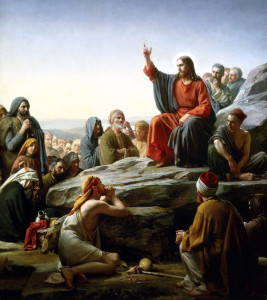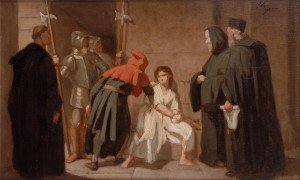A Pamphlet Asks About Traditions…
 This is part of a continuing series where I investigate the claims made by a pamphlet that was left for me asserting that Catholicism is not Christian. You can read the pamphlet in it’s entirety here: (page 1 and page 2). Today we’ll be discussing the short section on page 2 entitled “Traditions”.
This is part of a continuing series where I investigate the claims made by a pamphlet that was left for me asserting that Catholicism is not Christian. You can read the pamphlet in it’s entirety here: (page 1 and page 2). Today we’ll be discussing the short section on page 2 entitled “Traditions”.
What is Tradition based on?
This section opens with a statement that Catholic Tradition is founded on documented forged by their leaders. As we previously discussed, the Catholic Church was founded by Christ and not Constantine which covers the ‘Donations of Constantine’ assertion. The author also mentions the Isodorian Decretals, which were a set of 9th century documents attempting to justify the position of bishops by supporting them with false documents purportedly authored by early popes. I have not studied these documents extensively myself, but I have found several sources that affirm that these documents are forgeries and that no serious theologian has asserted otherwise since the 19th century.
The important thing that I notice is that these documents were created in the 9th century, which essentially means that the Catholic Church had been practicing it’s faith for around 800 years. Traditions in practice by this time were many generations old, and therefore could not have been founded on the back of this set of forged documents.
Sacred Tradition is the practice of the faith that has been transmitted by word or practice and not by writing. This is alluded to in John 20:30-31:
And many other signs truly did Jesus in the presence of his disciples, which are not written in this book:
But these are written, that ye might believe that Jesus is the Christ, the Son of God; and that believing ye might have life through his name.
And John 21:25:
And there are also many other things which Jesus did, the which, if they should be written every one, I suppose that even the world itself could not contain the books that should be written. Amen.
The Apostles traveled with Jesus, they lived with Jesus, and they witnessed these other signs. It stands to reason that in being taught directly from Christ, the Apostles would themselves transmit these teachings and practices to others. Christ Himself is the foundation upon which Sacred Tradition is built. Further, there is plenty of valid evidence that illustrates that the early Church Fathers held to some of the same traditions and practices that we conform to today. For more information on this, I highly suggest Jimmy Akin‘s book “The Fathers Know Best“.
Misunderstanding Mark
The pamphlet continues to quote Mark 7:7 as evidence that Tradition is bad:
But in vain do they worship me, teaching for doctrines the commandments of men.
This is a simple matter of cherry-picking Scripture and why it is dangerous. Christ was speaking with the Pharisees about their practice of hand-washing before meals, and his admonishment was directed at them for this practice. The line to be drawn is clear: there is a marked difference between traditions that take man away from God’s Commandments (in fact, the rest of Christ’s discussion on this matter drives forward that point) and those that Sacred Tradition transmitted by Christ to his Apostles.
The author cites examples of things that the church has changed or removed: fish on Friday got removed (actually, it’s still there), Saint Christopher (he’s still there too), and the acceptance of mixed marriages (it is allowed, but still discouraged). These are good examples of Church doctrines that can evolve. It is the job of the Magesterium to instruct regarding such things, in order to ensure that these practices lead people further in their spiritual life.
I do think that the author of the pamphlet does make an accidental point, however. The point of Sacred Tradition is that it further allows us to relate to Christ and worship him. Tradition itself is there to support and underscore the teachings of Christ, not to change or override it.
Infallible Teachings
The author again makes an error in associating the infallible teachings of the Church with the practice of the doctrines listed above. Any teaching declared infallible means that it has been revealed to us by God. The examples given of transubstantiation, purgatory, Mary’s immaculate conception, and papal infallibility are not of the same pedigree as the dietary practices or veneration guidelines presented above.
Each of these examples can be traced back to what God has revealed to us, and in each case there is biblical and traditional evidence to support each of these teachings. There is ample evidence to support that these practices have been present throughout the transmission of Catholicism, but simply were just not specifically defined until a later time. I will cover each of these in some detail in coming weeks and months, in order to give each topic the appropriate focus that it deserves.

 This is part of a continuing series where I investigate the claims made by a pamphlet that was left for me asserting that Catholicism is not Christian. You can read the pamphlet in it’s entirety here: (
This is part of a continuing series where I investigate the claims made by a pamphlet that was left for me asserting that Catholicism is not Christian. You can read the pamphlet in it’s entirety here: (